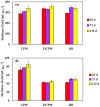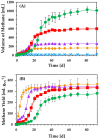A Citrus Peel Waste Biorefinery for Ethanol and Methane Production
- PMID: 31277372
- PMCID: PMC6651380
- DOI: 10.3390/molecules24132451
A Citrus Peel Waste Biorefinery for Ethanol and Methane Production
Abstract
This paper deals with the development of a citrus peel waste (CPW) biorefinery that employs low environmental impact technologies for production of ethanol and methane. Three major yeasts were compared for ethanol production in batch fermentations using CPW pretreated through acid hydrolysis and a combination of acid and enzyme hydrolysis. The most efficient conditions for production of CPW-based hydrolyzates included processing at 116 °C for 10 min. Pichia kudriavzevii KVMP10 achieved the highest ethanol production that reached 30.7 g L-1 in fermentations conducted at elevated temperatures (42 °C). A zero-waste biorefinery was introduced by using solid biorefinery residues in repeated batch anaerobic digestion fermentations achieving methane formation of 342 mL gVS-1 (volatile solids). Methane production applying untreated and dried CPW reached a similar level (339-356 mL gVS-1) to the use of the side stream, demonstrating that the developed bioprocess constitutes an advanced alternative to energy intensive methods for biofuel production.
Keywords: bioethanol; biomethane; biorefinery; biorefinery residues; citrus peel waste.
Conflict of interest statement
The authors declare no conflict of interest.
Figures



 ), dried citrus peel waste (DCPW) (
), dried citrus peel waste (DCPW) ( ), and solid biorefinery residues (BR) (
), and solid biorefinery residues (BR) ( ). A control fermentation was conducted without the addition of CPW (
). A control fermentation was conducted without the addition of CPW ( ), while all experiments were conducted at 37 °C. Dashed lines represent the time where substrate refeed was applied.
), while all experiments were conducted at 37 °C. Dashed lines represent the time where substrate refeed was applied.
 ), DCPW (
), DCPW ( ), solid BR (
), solid BR ( ), and in the control experiment (
), and in the control experiment ( ).
).

 ), 6 g L−1 (
), 6 g L−1 ( ), 12 g L−1 (
), 12 g L−1 ( ), and 24 g L−1 (
), and 24 g L−1 ( ) initial volatile solids of CPW. A control fermentation was performed without the addition of CPW (
) initial volatile solids of CPW. A control fermentation was performed without the addition of CPW ( ), while all experiments were conducted at 37 °C.
), while all experiments were conducted at 37 °C.Similar articles
-
High temperature alcoholic fermentation of orange peel by the newly isolated thermotolerant Pichia kudriavzevii KVMP10.Lett Appl Microbiol. 2016 Jan;62(1):75-83. doi: 10.1111/lam.12514. Lett Appl Microbiol. 2016. PMID: 26510181
-
Impact of biochar on the anaerobic digestion of citrus peel waste.Bioresour Technol. 2016 Sep;216:142-9. doi: 10.1016/j.biortech.2016.04.106. Epub 2016 May 10. Bioresour Technol. 2016. PMID: 27236401
-
A biorefinery for conversion of citrus peel waste into essential oils, pectin, fertilizer and succinic acid via different fermentation strategies.Waste Manag. 2020 Jul 15;113:469-477. doi: 10.1016/j.wasman.2020.06.020. Epub 2020 Jun 27. Waste Manag. 2020. PMID: 32604008
-
Recent advances in the biological valorization of citrus peel waste into fuels and chemicals.Bioresour Technol. 2021 Mar;323:124603. doi: 10.1016/j.biortech.2020.124603. Epub 2021 Jan 3. Bioresour Technol. 2021. PMID: 33406467 Review.
-
Upflow anaerobic sludge blanket reactor--a review.Indian J Environ Health. 2001 Apr;43(2):1-82. Indian J Environ Health. 2001. PMID: 12397675 Review.
Cited by
-
Citrus Pomace as a Source of Plant Complexes to Be Used in the Nutraceutical Field of Intestinal Inflammation.Antioxidants (Basel). 2024 Jul 19;13(7):869. doi: 10.3390/antiox13070869. Antioxidants (Basel). 2024. PMID: 39061937 Free PMC article.
-
Advances in the Application of the Non-Conventional Yeast Pichia kudriavzevii in Food and Biotechnology Industries.J Fungi (Basel). 2023 Jan 27;9(2):170. doi: 10.3390/jof9020170. J Fungi (Basel). 2023. PMID: 36836285 Free PMC article. Review.
-
Mediterranean Food By-products as a Valuable Source of Bioactive Compounds with Health Properties.Curr Med Chem. 2025;32(21):4154-4175. doi: 10.2174/0109298673309549240723054831. Curr Med Chem. 2025. PMID: 39069712 Review.
-
Bioactive Compounds of Agro-Industrial By-Products: Current Trends, Recovery, and Possible Utilization.Antioxidants (Basel). 2025 May 28;14(6):650. doi: 10.3390/antiox14060650. Antioxidants (Basel). 2025. PMID: 40563284 Free PMC article. Review.
References
-
- Kosseva M.R. Sources, characterization, and composition of food industry wastes. In: Kosseva M.R., Webb C., editors. Food Industry Wastes. 1st ed. Elsevier Inc.; London, UK: 2013. pp. 37–60.
-
- FAO . Citrus Fruit Statistics 2015. FAO; Rome, Italy: 2016. p. 53.
-
- Marin F.R., Soler-Rivas C., Benavente-Garcia O., Castillo J., Perez-Alvarez J.A. By-products from different citrus processes as a source of customized functional fibres. Food Chem. 2007;100:736–741. doi: 10.1016/j.foodchem.2005.04.040. - DOI
-
- Wilkins M.R. Effect of orange peel oil on ethanol production by Zymomonas mobilis. Biomass Bioenergy. 2009;33:538–541. doi: 10.1016/j.biombioe.2008.08.010. - DOI
-
- Negro V., Bernardo R., Fino D. Recovery of energy from orange peels through anaerobic digestion and pyrolysis processes after D-limonene extraction. Waste Biomass Valoriz. 2018;9:1331–1337. doi: 10.1007/s12649-017-9915-z. - DOI
MeSH terms
Substances
LinkOut - more resources
Full Text Sources

